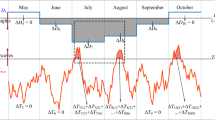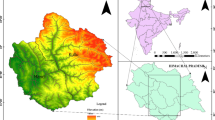Abstract
The main goal of this study is to examine future changes in meteorological, hydrological drought under the impact of climate change in Dong Nai River Basin, using Standardized Precipitation Index (SPI) and Stream flow Drought Index (SDI). The Soil and Water Assessment Tool (SWAT) is used as a simulated tool to estimate the streamflow in baseline (1980–2005) and climate change (RCP 4.5, 2016–2035) scenarios for meteorological, hydrological calculation. The results show that both types of drought tend to occur in the dry season. The area affected by meteorological and hydrological drought expand in both baseline and RCP 4.5 scenarios. In addition, meteorological drought duration is also significantly increased, especially severely drought months. Although it was detected slightly decreasing in the duration of hydrological drought, the number of months which is occurred moderately drought in sub-basins still goes up in the climate change scenario. These findings could be useful for water shortage assessment and allocation planning in this area in the climate change context in the Dong Nai River Basin.











Similar content being viewed by others
Availability of data and material
Not applicable.
Code availability
Not applicable.
References
Abbaspour KC (2015) SWATCUP: SWAT calibration and uncertainty program - a users manual. Eawag - Swiss Federal Institute of Aquatic Science and Technology, Switzerland
Abbaspour KC, Yang J, Maximov I, Siber R, Bogner K, Mieleitner J, Zobrist J, Srinivasan R (2007) Modelling hydrology and water quality in the pre-alpine/alpine Thur watershed using SWAT. J Hydrol 333(2–4):413–430. https://doi.org/10.1016/j.jhydrol.2006.09.014
Arnold J, Kiniry J, Srinivasan R, Williams J, Haney E, Neitsch S (2012) Soil and water assessment tool, input/output documentation version 2012, technical report no. 439. Texas water resources institute, a&M University system College Station, Texas
Dai A (2013) Increasing drought under global warming in observations and models. Nat Clim Chang 3(1):52–58. https://doi.org/10.1038/nclimate1633
Demirel MC, Venancio A, Kahya E (2009) Flow forecast by SWAT model and ANN in Pracana basin, Portugal. Adv Eng Softw 40(7):467–473. https://doi.org/10.1016/j.advengsoft.2008.08.002
General Department of Environment - MONRE (2019) Dong Nai river catment information portal. lvsdongnai.cem.gov.vn. Accessed 01/03/2019
Gupta HV, Sorooshian S, Yapo PO (1999) Status of automatic calibration for hydrologic models: comparison with multilevel expert calibration. J Hydrol Eng 4(2):135–143. https://doi.org/10.1061/(ASCE)1084-0699(1999)4:2(135)
Haied N, Foufou A, Chaab S, Azlaoui M, Khadri S, Benzahia K, Benzahia I (2017) Drought assessment and monitoring using meteorological indices in a semi-arid region. Energy Procedia 119:518–529. https://doi.org/10.1016/j.egypro.2017.07.064
Hisdal H, Tallaksen LM (2003) Estimation of regional meteorological and hydrological drought characteristics: a case study for Denmark. J Hydrol 281(3):230–247. https://doi.org/10.1016/S0022-1694(03)00233-6
Huyen NT, Tu LH, Tram VNQ, Minh DN, Liem ND, Loi NK (2017) Assessing the impacts of climate change on water resources in the Srepok watershed, Central Highland of Vietnam. J Water Clim Change 8(3):524–534. https://doi.org/10.2166/wcc.2017.135
Krause P, Boyle D, Bäse F (2005) Comparison of different efficiency criteria for hydrological model assessment. Adv Geosci 5:89–97. https://doi.org/10.5194/adgeo-5-89-2005
Kreft S, Eckstein D (2013) Global climate risk index 2014: who suffers most from extreme weather events? Weather-related loss events in 2012 and 1993 to 2012. Briefing paper, Germanwatch eV Bonn
Loi NK, Liem ND (2012) Assessing Water discharge in Be River Basin, Vietnam using SWAT model. International SWAT Conference Proceedings, Ho Chi Minh City, Vietnam
Malutta S, Kobiyama M (2011) SWAT application to analyze the floods in Negrinho River basin–SC, Brazil. 12th international conference on urban drainage, Porto Alegre-RS, Brazil
MONRE (2016) Climate change and sea level rise scenarios in Viet Nam. Viet Nam publishing house of natural resources, Environment and Cartography, Ha Noi (In Vietnamese)
Moriasi DN, Arnold JG, Van Liew MW, Bingner RL, Harmel RD, Veith TL (2007) Model evaluation guidelines for systematic quantification of accuracy in watershed simulations. Trans ASABE 50 (3):885-900. Doi:https://doi.org/10.13031/2013.23153
Nalbantis I, Tsakiris G (2009) Assessment of hydrological drought revisited. Water Resour Manag 23(5):881–897. https://doi.org/10.1007/s11269-008-9305-1
Nash JE, Sutcliffe JV (1970) River flow forecasting through conceptual models part I—A discussion of principles. J Hydrol 10(3):282–290. https://doi.org/10.1016/0022-1694(70)90255-6
Nguyen HQ, Kappas M (2015) Modeling surface runoff and evapotranspiration using SWAT and beach for a tropical watershed in North Vietnam, compared to MODIS products. International Journal of Advanced Remote Sensing and GIS 4(1):1367–1384. https://doi.org/10.23689/fidgeo-2389
Nhi PTT, Khoi DN, Hoan NX (2019) Evaluation of five gridded rainfall datasets in simulating streamflow in the upper Dong Nai river basin, Vietnam. Int J Digital Earth 12(3):311–327. https://doi.org/10.1080/17538947.2018.1426647
Panagopoulos Y, Makropoulos C, Mimikou M (2012) Decision support for diffuse pollution management. Environ Model Softw 30:57–70. https://doi.org/10.1016/j.envsoft.2011.11.006
Paparrizos S, Maris F, Matzarakis A (2016) Integrated analysis and mapping of aridity over Greek areas with different climate conditions. Global NEST Journal 18(1):131–145
Paparrizos S, Maris F, Weiler M, Matzarakis A (2018) Analysis and mapping of present and future drought conditions over Greek areas with different climate conditions. Theor Appl Climatol 131(1–2):259–270. https://doi.org/10.1007/s00704-016-1964-x
Phan D, Wu C, Hsieh S (2011) Impact of climate change on stream discharge and sediment yield in northern Viet Nam. Water Resour 38(6):827–836. https://doi.org/10.1134/S0097807811060133
Sam TT, Khoi DN, Thao NTT, Nhi PTT, Quan NT, Hoan NX, Nguyen VT (2019) Impact of climate change on meteorological, hydrological and agricultural droughts in the lower Mekong River basin: a case study of the Srepok Basin, Vietnam. Water Environ J 33(4):547–559. https://doi.org/10.1111/wej.12424
SIWRP (2019) Newsletter of water resources forecasting and the water use planning for water supply in Dong Nai river catchment. Ho Chi Minh City
Thang LV, Khoi DN, Phi HL (2018) Impact of climate change on streamflow and water quality in the upper Dong Nai river basin, Vietnam. La Houille Blanche 1:70–79. https://doi.org/10.1051/lhb/2018010
Thang NV, Khiem MV, Mau ND, Tri TD (2014) Research on drought indices for southern central region. Meteorology and hydrology journal 639:49 - 55 (In Vietnamese)
Tinh ND, Chung NT, Binh TQ (2012) Meteorological drought forecast technology in Mekong delta. Irrigation and Environmental Science and Technology 37:(In Vietnamese)
Tuan DD, Hoang NV, Loi NV (2014) Meteorological drought assessment in Quang Tri province. Earth Sci 36(2):160–168 (In Vietnamese)
Wilhite DA, Glantz MH (1985) Understanding: the drought phenomenon: the role of definitions. Water Int 10(3):111–120. https://doi.org/10.1080/02508068508686328
Wilson CO, Weng Q (2011) Simulating the impacts of future land use and climate changes on surface water quality in the Des Plaines River watershed, Chicago metropolitan statistical area, Illinois. Sci Total Environ 409(20):4387–4405. https://doi.org/10.1016/j.scitotenv.2011.07.001
Winai W, Kobkiat P (2011) Integrated hydrologic and hydrodynamic model for flood risk assessment for Nam Loei bazin, Thailand. The 1st EIT international conference on water resources engineering, Bangkok, Thailand
World Meteorological Organization (WMO), Global Water Partnership (GWP) (2016) Handbook of drought indicators and indices. Geneva
Yu Y, Liu J, Yang Z, Cao Y, Chang J, Mei C (2018) Effect of climate change on water resources in the Yuanshui River basin: a SWAT model assessment. Arab J Geosci 11(11):270. https://doi.org/10.1007/s12517-018-3619-y
Zahabiyoun B, Goodarzi M, Bavani AM, Azamathulla H (2013) Assessment of climate change impact on the Gharesou River basin using SWAT hydrological model. CLEAN–Soil, Air, Water 41(6):601–609. https://doi.org/10.1002/clen.201100652
Funding
This research is funded by Ho Chi Minh city Department of Science and Technology (DOST) and Institute For Computational Science And Technology at Ho Chi Minh City (ICST) under contract number 29/2017/HĐ-SKHCN dated 31 Ocbober 2017. The research of Ayse Kortun was funded by the Newton Fund Institutional Link through the Fly-by Flood Monitoring Project under Grant ID 428328486, which is delivered by the British Council. We want to send our sincere thanks to DOST and ICST and Newton Fund for funding this project.
Author information
Authors and Affiliations
Contributions
V.T.L., H.M.D. and N.K.L. conceived the idea of this investigation. V.T.L., V.N.Q.T. and H.M.D. developed the general framework of the methodology. D.N.D.P., N.D.L. and L.D.N collected input data and performed preliminary data processing. V.T.L., V.N.Q.T., N.D.L., C.Y. and A.K. set up, calibrated and validated hydrological model. D.N.D.P., L.D.N. and C.Y. performed most of other statistical analysis. V.T.L., N.D.L. and A.K. prepared all diagrams, plots and maps. V.T.L. and V.N.Q.T. wrote the manuscript. H.M.D. and N.K.L. proofread the manuscript and supervised this study. All authors discussed and commented on the manuscript.
Corresponding author
Ethics declarations
Conflict of interest
The authors declare that they have no conflict of interest.
Additional information
Publisher’s note
Springer Nature remains neutral with regard to jurisdictional claims in published maps and institutional affiliations.
Appendix
Appendix
1.1 SWAT
SWAT integrates many of ARS’s models, developed from the Simulator for Water Resources in Rural Basin (SWRRB) [3]. This model, which is a water and soil assessment tool, developed by Dr. Jeff Arnold of the Agricultural Research Service (ARS) Agricultural Research Service of the United States Department of Agriculture and Prof. Srinivasan of Texas A & M University, USA. SWAT allows a number of different physical processes to be simulated in a watershed. The hydrologic cycle as simulated by SWAT is based on the water balance equation:
where SWt is the final soil water content (mm H2O), SW0 is the initial soil water content on day i (mm H2O), t is the time (days), Rday is the amount of precipitation on day i (mm H2O), Qsurf is the amount of surface runoff on day i (mm H2O), Ea is the amount of evapotranspiration on day i (mm H2O), wseep is the amount of water entering the vadose zone from the soil profile on day i (mm H2O), and Qgw is the amount of return flow on day i (mm H2O) (Fig. 12).
Create SWAT–SUFI2 Input file [3]
1.2 SWATCUP
Research using SWAT-CUP tool to calibrate and test the model. The SWAT-CUP consists of five calculation methods (SUF12, GLUE, PARASOL, MCMC, PSO) [1]. The SUFI-2 algorithm [2] in the SWAT-CUP software package was used for model calibration, validation, sensitivity, and uncertainty analysis. Model correction is conducted in two phases: phase one is the flow correction, after the flow is well adjusted, the second stage is the TSS correction. Input data for SWAT-CUP should include:
-
Simulation results of the SWAT model.
-
Daily monitoring data for flow and TSS.
-
Model calibration kit.
Steps to program with:
-
Step 1: Determine the sensitivity parameters for the model.
-
Step 2: The program calibrates the input data with the upper limit, below each parameter, the actual comparison data.
-
Step 3: Edit the input file with the new value of the parameters.
-
Step 4: Simulate and relaunch the SWAT model.
-
Step 5: Compare the reliability test results to the value of the optimal parameters.
1.3 Model performance evaluation
The coefficient of determination (R2) [11] and Nash–Sutcliffe Index (NSI) [18] and PBIAS [7] were used to evaluate the model performance. Those coefficients are calculated as following equations:
Where, \( {Q}_i^{obs} \) is the observed discharge at time i, \( {\overline{Q}}^{obs} \) is the average observed discharge, \( {Q}_i^{sim} \) is the simulated discharge at time i, \( {\overline{Q}}^{sim} \) is the average simulated discharge, and n is the number of registered discharge data.
Rights and permissions
About this article
Cite this article
Linh, V.T., Tram, V.N.Q., Dung, H.M. et al. Meteorological and Hydrological Drought Assessment for Dong Nai River Basin, Vietnam under Climate Change. Mobile Netw Appl 26, 1788–1800 (2021). https://doi.org/10.1007/s11036-021-01757-x
Accepted:
Published:
Issue Date:
DOI: https://doi.org/10.1007/s11036-021-01757-x





